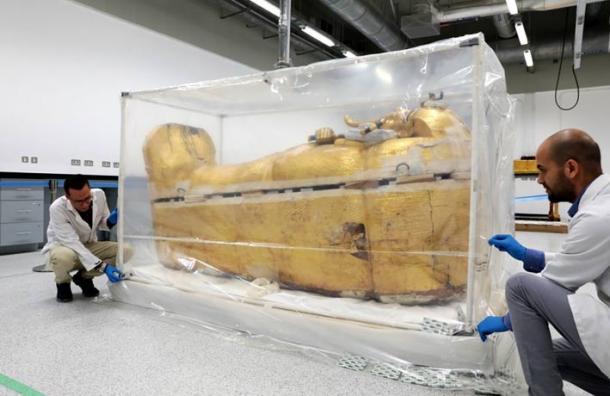
Large Gilded Coffin of King Tut Is Moved For The First Time
The Ministry of Antiquities in Egypt has announced that the outer coffin of Tutankhamun has been removed from its tomb - for the first time since it was uncovered. Urgent restoration work needs to be carried out on the outer coffin of King Tut in order to preserve it. It is expected that the gilded coffin of one of Egypt’s most famous pharaoh’s will soon be put on public display for the first time.
This coffin is made of wood and gilded plaster and portrays “the king in the Osirian shape, with arms crossed upon his chest and holding the insignia, the flail and the crook” according to a press release by the Ministry of Antiquities. It was the outer of the three nested coffins that held the mummy of the pharaoh and measures 223.5 cm (7 ¼ feet) in length by 84cm (2 ¾ feet) and has silver handles.
The two inner coffins were removed to Cairo years ago, but the outer coffin was left in the tomb of the monarch in the Valley of the Kings. Humidity and the environment led to the deterioration of the integrity of the coffin. An examination of the casket produced worrying results. The experts called for immediate restoration work to be carried out to save the priceless object.

Immediate restoration work is needed due to deterioration of the outer coffin of King Tut (Ministry of Antiquities)
Delicate Operation to Move the Coffin
In July of this year, the outer coffin of the pharaoh was removed from the Valley of the Kings and taken to the Grand Egyptian Museum (GEM) not far from the Giza pyramids. It was taken on a 380-mile (610 km) journey, from the South of Egypt, during which it was closely guarded by the Egyptian Tourism and Antiquities Police. The Ministry of Antiquities statement describes the delicate process of the coffins journey, including the “moving team used anti-vibration units to protect the weak structure of the piece”. This is the first time that it has left the tomb since it was discovered in 1922.
After reaching its destination the coffin was taken to a special room in the museum, where it was fumigated for a week. The object was then taken to the conservation center. China Plus reports that the Egyptian Minister of Antiquities stated that “the sterilization work of King Tut's coffin started on July 22 at the wood restoration plant of the GEM in preparation for an all-out restoration process”. An initial investigation revealed that the coffin was in a poor condition and its gilded plaster had cracked in many places especially on its lid.

Gilded plaster on the coffin of King Tut has cracked in many places. (Ministry of Antiquities)
The restoration work is being carried out by specialists and it will take approximately eight months. Newsweek reports that “This is the first time authorities have carried out work on the coffin since it was discovered almost a century ago”. Much of the work will be done by hand and will use non-invasive equipment to ensure that the coffin is not damaged. It will then be chemically treated. The Daily Mail reports that “any layers of plaster that have broken away will be replaced in their original location”.
- When Tutankhamun Lay in State: Do Floral Collars Hint at Sinister Turn of Events? – Part II
- Instruments of Mass Destruction: Do Tutankhamun’s Trumpets Really Summon War?
- Excitement Mounts as New Infrared Scan in Tomb of Tutankhamun Suggests Hidden Chamber

Restoration laboratory at the Grand Egyptian Museum with many artifacts from King Tut’s tomb. (Ministry of Antiquities)
The Large Gilded Coffin of King Tut, the Golden Pharaoh
The outer coffin was found in the tomb of Tutankhamun, who is often known as the Golden Pharaoh, because of the treasures found buried with him. He ascended the throne at nine and reigned from 1332 BC and 1323 BC and was a member of the 18 th Dynasty. Recent research has shown that he died from a disease and was not assassinated as once thought. His tomb was found by Howard Carter in November 1922, its discovery caused a global sensation. For many people around the world, Tutankhamun has become one of the symbols of Ancient Egypt.
See.egy news reports that “The coffin is set to be displayed in the GEM along with other golden coffins”. This will be the first time that the three coffins found in Tutankhamun’s tomb will be together since 1922. It is expected that the display will boost visitor numbers to the GEM.
Top image: Large Gilded Coffin of King Tut. Source: Ministry of Antiquities
By Ed Whelan















